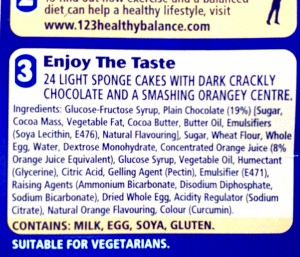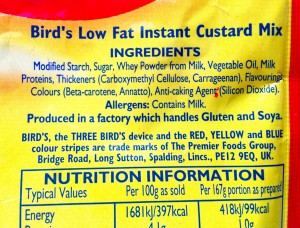Raising agents
Raising agents are additives (liquid or powder) that are there to ensure the product not only rises but also has an even texture. For instance, a well known raising agent, bicarbonate of soda/baking soda (E501) or technically sodium bicarbonate (as used in the Jaffa Cakes above*), reacts with the ingredients around it (the acidity and the moisture) when heated and produces bubbles of gas (carbon dioxide) which expand and raise the mixture around it and then becomes encased in that mixture as it cooks and sets, creating a uniform and stable structure and texture. Baking powder is bicarbonate soda and cream of tartar mixed (with a starch usually) to be a more all-in-one raising agent as the cream of tartar (E336(i) – a by-product of wine making) provides the acidic element needed to trigger the bicarb soda.
Natural processes like whipping air into egg whites or batter, sifting flours and rubbing fats into them all assist in the raising and structure of baked goods, and similarly using water to create steam during the baking process will raise the mixture around it up till it sets when cooked, such as the process used in making Yorkshire puddings. Yeast is a perfect natural raising agent – multiplying in heat and fermenting to create the carbon dioxide and alcohol that will expand and burn off in the cooking process leaving a well structured and risen product.
*Three are actually listed in the ingredients list above – sodium bicarbonate (aka baking soda E500(i)), ammonium bicarbonate (E503(ii) actually part of the group of acidity regulators and anti-caking agents and used as an acidity regulator) and disodium diphosphate (E450(i) actually part of the group of emulsifiers and used for that purpose.
Anti-caking agents
Anti-caking agents are added to food products to ensure they remain free flowing and prevent them from clumping together, and so this means the product can retain it’s long shelf life and be used at any point required in an even manner. Main examples are powders like dried milk or creamer, drinking chocolate, soup or cake mixes and items like icing sugar, grated cheeses and salt. The additive is necessary as without it there is a high possibility that minute water absorption (atmospheric humidity) would cause the product to clump together and rehydrate, causing it to spoil and/or be difficult to use. Sometimes the anti-caking element is added before processing and is often for the safeguarding of the machinery involved as much as the end result produced and it’s journey onwards. Sugar and powdered milk will lump and stick together during processing, packing and storage without the addition of the agents.
The most commonly used anti-caking agent (multi-functional additive) is silicon dioxide (E551) – as used in the instant custard mix above – also called silica and is essentially sand (although amethysts and quartz are versions too…but not used in food processing…!) It is also thought to be a useful mineral to our general health as it is part of collagen and used to make our hair and nails. It is found naturally in many foods like fruits, oats, nuts, beans and leafy greens and is added as an active ingredient to supplements and as an enhancer.
Other manufactured and mineral based anti-caking agents include magnesium carbonate (E504), calcium silicate (E552), dicalcium phosphate (E341) and sodium aluminosilicate (E554). Naturally sourced agents are potato starch, kaolin, and talc.


I will like to read more of your article.
Especially on bicarbonate soda.
If it is an anti caking agent.
Also the measurement that is to be used while producing 50kg of icing sugar .